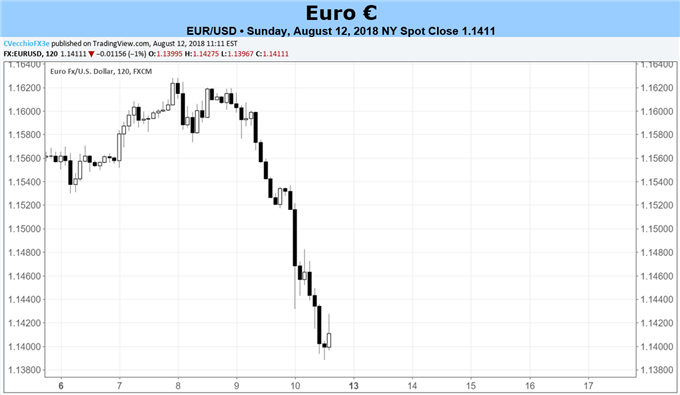
Fundamental Forecast for EUR/USD: Bearish
- With the Turkish Lira in freefall, contagion hit European financial markets as investors questioned whether European banks’ exposure to Turkey could provoke another financial crisis in the region.
- Until the Turkey issue gets on the path to resolution – it’s going to get worse before it gets better – there is very little that is going to impact the Euro otherwise (particularly this week’s economic calendar).
- The IG Client Sentiment Index has shifted to a ‘mixed’ outlook from ‘bullish’ earlier last week.
See our long-term forecasts for the Euro and other major currencies with the DailyFX Trading Guides.
The Euro may not have been the worst performing major currency, but it had a terrible end to last week as fresh concerns emerged on its eastern front. With the Turkish Lira in freefall, contagion hit European financial markets as investors questioned whether European banks’ exposure to Turkey could provoke another financial crisis in the region. EUR/JPY dropped by -1.74%, wiping out all of its progress since May 30 in the process, while EUR/USD slid by -1.36%, falling to its lowest level in 13-months.
Needless to say, after a relatively quiet period for the Euro – many of the EUR-crosses had been rangebound over the past two months – volatility has exploded higher in a detrimental manner. What was previously seen as an expected period of monetary policy being on autopilot, now is riddled with questions about whether or not the European Central Bank will even have the ability to withdraw its monetary stimulus on its current projected timeline (reminder: end QE in December 2018; raise rates in “summer 2019”).
According to a report released by the Financial Times on Friday, the ECB’s supervisory wing, the Single Supervisory Mechanism, had been in the process of reviewing European banks’ exposure to Turkey following the sharp depreciation seen in the Turkish Lira in recent months.
ECB regulators have begun to express concern that Turkish borrowers are improperly hedged against Lira weakness, and may begin to default on their foreign currency loans – meaning European banks’ balance sheets could be coming back under pressure. Per the Bank of International Settlements, Turkish borrowers owe Spanish banks $83.3 billion, French banks $38.4 billion, and Italian banks $17 billion.
Accordingly, the juxtaposition between the ECB and the Fed could not be more apparent now, with the Fed on the cusp of raising rates by 25-bps again next month, and the ECB being in the potential position to needing to provide emergency liquidity assistance to financial institutions under its purview. Until the Turkey issue gets on the path to resolution – it’s going to get worse before it gets better – there is very little that is going to impact the Euro otherwise (particularly this week’s economic calendar).
Traders should be looking both ways for volatility moving forward, especially now that positioning has been flattened out. Per the CFTC’s COT report released for the week ended August 7, speculators held +10.6K net-long Euro contracts, a -93% decline from the all-time high set during the week ended April 17 (+151.5K contracts).
Given that the Turkish Lira meltdown didn’t occur until Friday, the ensuing knock-on impact to the Euro wouldn’t have appeared in the most recent COT report; but it would seem very likely that, given the already thin positioning for the week ended August 7, speculators may have turned net-short the Euro for the first time since the week ended May 1, 2017.
FX TRADING RESOURCES
Whether you are a new or experienced trader, DailyFX has multiple resources available to help you: an indicator for monitoring trader sentiment; quarterly trading forecasts; analytical and educational webinars held daily; trading guides to help you improve trading performance, and even one for those who are new to FX trading.
--- Written by Christopher Vecchio, CFA, Senior Currency Strategist
To contact Christopher, email him at cvecchio@dailyfx.com
Follow him in the DailyFX Real Time News feed and Twitter at @CVecchioFX.





